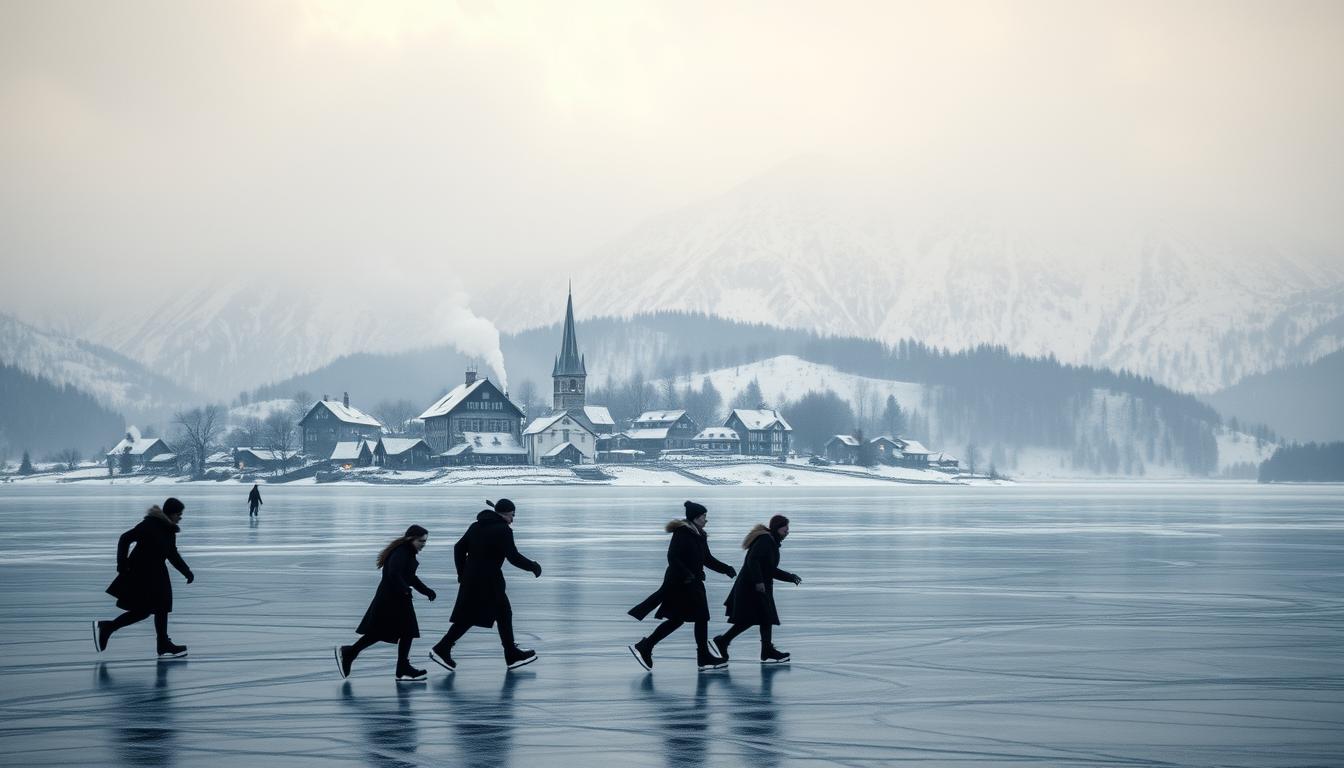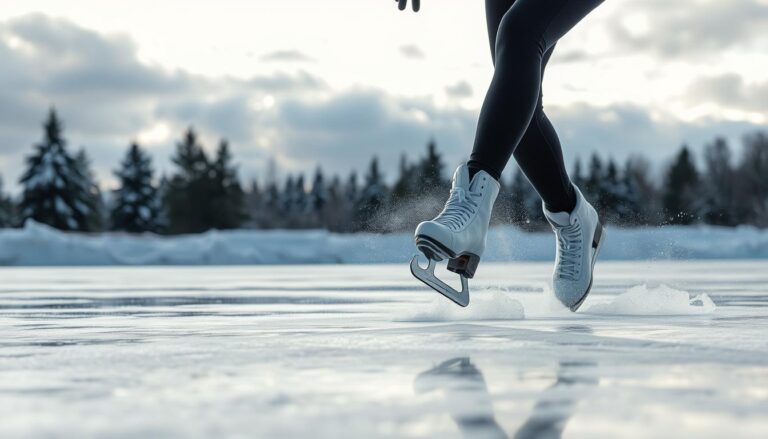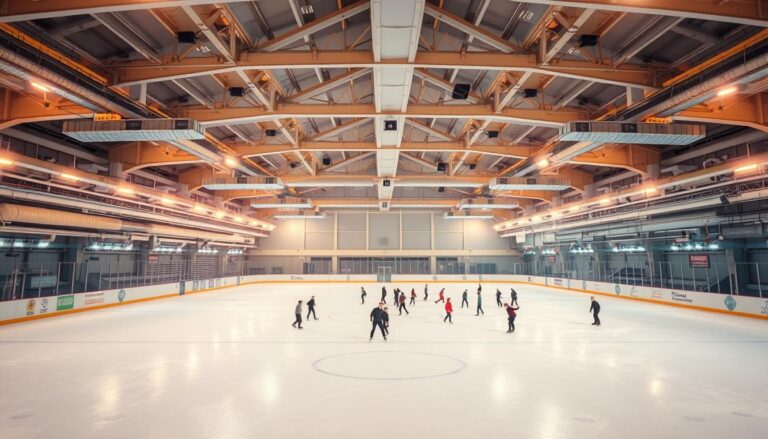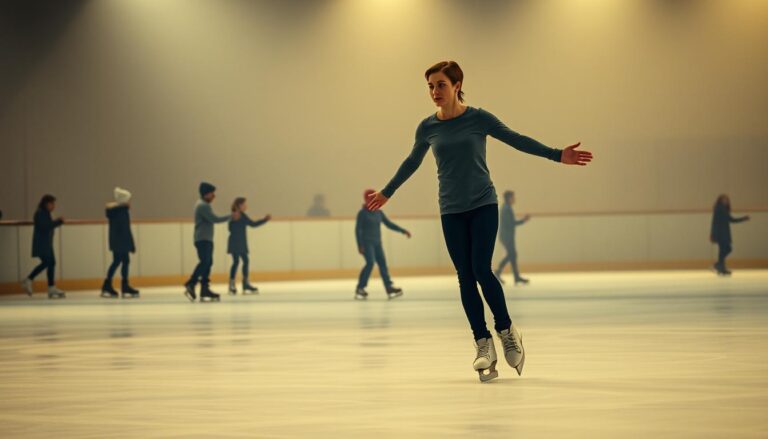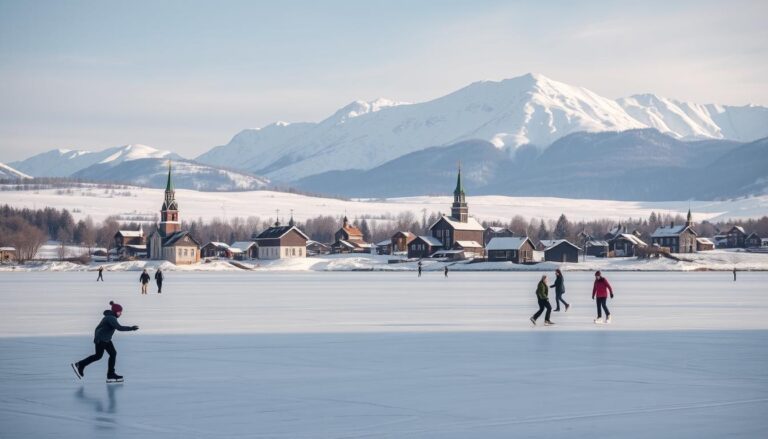Who Invented Ice Skating? The Fascinating History
Imagine a world where moving on ice was a matter of survival, not fun. The history of ice skating goes back thousands of years. It shows how humans adapted and innovated.
Ice skating’s roots are ancient, long before we had modern blades. Early people used animal bones attached to their feet. This made the first skates, changing how people moved in cold places.
Figuring out who invented ice skating is tricky. Early people in Northern Europe, like Scandinavia, were the first to skate. They used it to survive, not just for fun.
Those early skates were made from animal bones, like horse or cow legs. People attached these bones to leather straps. This made it easier to move on ice, connecting people in winter.
Learning about ice skating history shows us how adaptable humans are. What started as a way to survive turned into a sport. Ice skating has come a long way, from Finland’s frozen lakes to the Olympics.
Exploring ice skating’s history, we see how attaching blades to feet changed winter. It’s not just a sport; it’s a story of human creativity and overcoming challenges.
The Ancient Origins of Ice Skating
Ice skating has a long history, dating back thousands of years. It shows how ancient humans found ways to move on frozen land. They turned tough winter landscapes into paths of chance.
The first to skate were people in Northern Europe. They found clever ways to glide on ice. Archaeology gives us a peek into their early skating ways.
Archaeological Evidence from Northern Europe
Archaeologists have found amazing artifacts from early skaters. In places like Sweden and Finland, they’ve uncovered secrets of ancient skating.
- Bone skates from 3000 BCE
- Proof of smart winter travel
- Adaptation to cold weather
First Ice Skates Made from Animal Bones
The first skates were made from animal bones, like horse and deer. These early skates helped people move smoothly on ice.
These bone skates had special features:
- Smoothed bones for less friction
- Leather straps for a secure fit
- Lightweight for easy carrying
Prehistoric Transportation Methods
Ice skating was more than fun; it was a survival tool. Ancient groups used skates to hunt, trade, and explore in winter. It showed their amazing ability to adapt.
The history of ice skating shows human creativity at its best. It turned hard environments into paths for movement and survival.
Who Invented Ice Skating: Tracing the First Skaters
The story of ice skating is more than just one person’s idea. It’s a journey of how humans adapted and innovated across cultures and lands. Ancient people found ways to move on ice, turning survival into an art.
Studies have shown who first started ice skating. They found early skating in Northern Europe. The first skates were made from animal bones, showing human creativity.
- Prehistoric bone skates discovered in Finland
- Scandinavian cultures pioneering skating techniques
- Sami people’s innovative transportation methods
Different cultures saw ice skating in their own way. The Sami people of Scandinavia made skating a key part of winter travel. Their skills let them move easily on ice, showing how necessity can lead to talent.
| Region | Skating Material | Primary Purpose |
|---|---|---|
| Finland | Animal Bones | Transportation |
| Scandinavia | Wooden Runners | Hunting/Mobility |
| Netherlands | Iron Blades | Recreation |
We can’t say one person invented ice skating. But early innovations set the stage for today’s sport. Each culture added something special, shaping the ice skating we know now.
Early Ice Skating in Scandinavia and Finland
The history of ice skating began in Northern Europe’s cold landscapes. It was a time when people had to be creative to survive. They used ice skating to move around on frozen lakes and rivers.
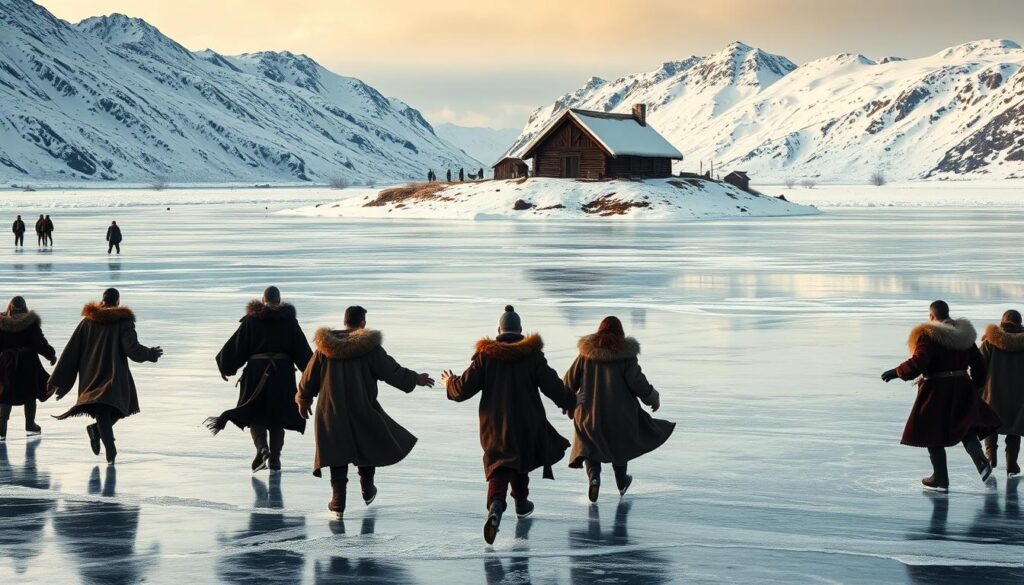
The people of the North developed amazing skating skills. These skills were not just for getting around. They were a result of needing to survive the cold winters.
Viking Age Skating Traditions
Vikings were known for their ice skating skills. They made skates from bones to move across the icy lands. Their skating was important for:
- Hunting on frozen landscapes
- Military movements
- Trading in winter
- Exploring waterways
Cultural Significance in Nordic Countries
Ice skating was more than a way to get around in Scandinavian societies. It was a way to:
- Build community
- Stay fit
- Have fun
- Show off skills
Development of Skating Techniques
Over time, Nordic skaters got better and better. They created new ways to move on ice. These techniques are part of what we see in skating today.
| Skating Technique | Purpose | Historical Significance |
|---|---|---|
| Gliding Stride | Efficient Movement | Reduced Energy Expenditure |
| Sharp Turning | Navigation | Survival in Complex Terrains |
| Long-Distance Skating | Transportation | Trade and Communication |
The history of ice skating in Scandinavia is a story of survival, skill, and culture. It shows how a basic need became an art form loved by many around the world.
The Evolution of Ice Skate Design
The history of ice skating is a journey of innovation. It started with simple bone skates and has evolved to modern designs. These changes have made ice skating safer and more enjoyable.
Early ice skating shows amazing engineering progress. Skaters used what they found in nature. Let’s look at the main stages of skate design:
- Bone Skates: First primitive designs using animal leg bones
- Wooden Platforms: Introduction of more stable skating surfaces
- Metal Blades: Revolutionary improvement in speed and maneuverability
- Modern Composite Materials: Lightweight and high-performance designs
The switch to metal blades was a big step. It made skating smoother and more precise.
| Era | Skate Material | Key Characteristics |
|---|---|---|
| Prehistoric | Animal Bones | Basic transportation |
| Medieval | Wood with Bone Runners | Improved stability |
| 19th Century | Steel Blades | Enhanced speed and control |
| Modern Era | Composite Materials | Lightweight, high-performance |
Each new design made skating better. The curve in the blade was key. It allowed for more movement and skill.
Medieval Ice Skating: From Necessity to Recreation
The way people skated changed a lot in the medieval times. What started as a way to survive turned into a fun activity for people. Skaters found new ways to move on ice, making it an art.
In Northern Europe, communities found their own ways to skate. The Dutch were the first to really change skating, during their Golden Age.
Dutch Golden Age Skating Culture
The Netherlands was at the heart of new skating ideas. Dutch artists showed how important skating was to them:
- Frozen canals became places for people to meet
- Skating competitions became a big hit
- Skaters developed fancy moves
European Nobility’s Adoption of Skating
The rich and powerful soon loved ice skating too. Elegant courtiers glided across palace ponds, making skating a fancy skill.
Skating got more complex, with the nobility showing off their best moves. It went from a survival tool to a fancy pastime, leading to today’s figure skating.
See how medieval skaters made winter fun, full of connection, creativity, and joy!
The Introduction of Steel Blades
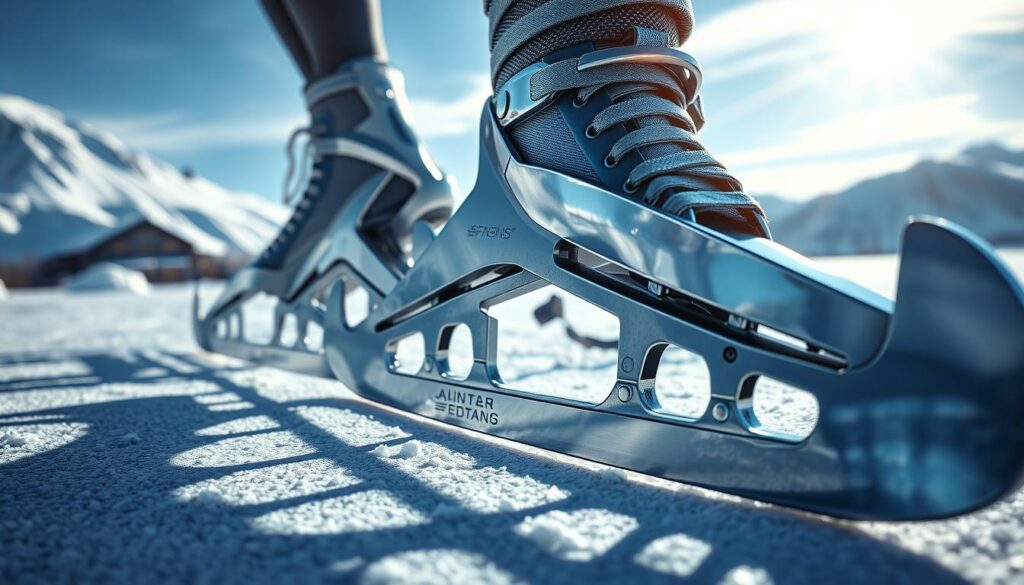
The history of ice skating changed with the arrival of steel blades. These new tools made gliding on ice smoother and more elegant. Ice skating evolved from a simple way to move to a beautiful sport.
Steel blades were a big step forward. Before, skaters used materials like bone, wood, and iron. These materials made skating slow and hard.
- Steel provided superior durability
- Increased skating speed and precision
- Allowed for more complex skating techniques
- Reduced friction on ice surfaces
Steel blades brought new chances for fun and competition in skating. Skaters could do more moves with better control and confidence.
| Blade Material | Performance Characteristics | Era of Use |
|---|---|---|
| Bone Skates | Limited mobility, rough gliding | Prehistoric to Medieval |
| Iron Blades | Improved stability, moderate speed | Medieval to Early 19th Century |
| Steel Blades | High precision, smooth gliding, complex techniques | Mid-19th Century Onwards |
The switch to steel blades was a key moment in ice skating history. It paved the way for today’s skating techniques and gear.
Ice Skating in Colonial America
The story of ice skating in America is full of survival, fun, and social ties. When European settlers came to the New World, they brought their love for ice skating. They turned frozen areas into lively winter spots.
Ice skating was more than just a way to get around in colonial America. It became a key way for people to come together during long winters. The history shows how ice became a place for socializing.
Early American Skating Clubs
The first skating clubs in America started in the late 1700s, mainly in the north. These clubs were important for developing skating skills that fit the American scene.
- Philadelphia had one of the first organized skating groups
- New England communities built detailed skating paths
- Military folks used skating for training and moving around in winter
Winter Social Activities
Skating turned from a useful skill to a favorite social event. Moonlight skating parties were big hits. They let young folks meet, find love, and enjoy the cold.
George Washington loved skating too. He helped make it popular among the colonists. These gatherings showed that skating was about more than just moving. It was about making connections with others.
The Birth of Figure Skating
The origin of ice skating changed when people started seeing it as more than just a way to get around. Figure skating became a stunning art form that mixed athletic skill with elegant movements. Early innovators found that skating could be truly amazing.
The roots of figure skating go back to European winters. Skaters first tried making patterns on the ice. They developed unique techniques that changed winter sports forever.
- Earliest figure skaters carved geometric shapes into ice
- Developed complex movement patterns
- Transformed skating from utility to artistic expression
In the mid-1800s, skating fans started writing down skating techniques and movements. The ice skating history shows how skating went from simple gliding to complex shows.
| Era | Skating Development | Key Innovations |
|---|---|---|
| Early 1800s | Basic Geometric Figures | Precise Ice Tracing |
| Mid-1800s | Artistic Movements | Choreographed Sequences |
| Late 1800s | Competitive Performances | Technical Scoring |
Figure skating as an art form amazed people all over the world. Skaters mixed athletic talent with creativity. This set the stage for the modern sport we see today.
Revolutionary Developments in the 19th Century
The 19th century was a big change for ice skating. New ideas came out that changed the sport forever. A new way of moving on ice started to appear.
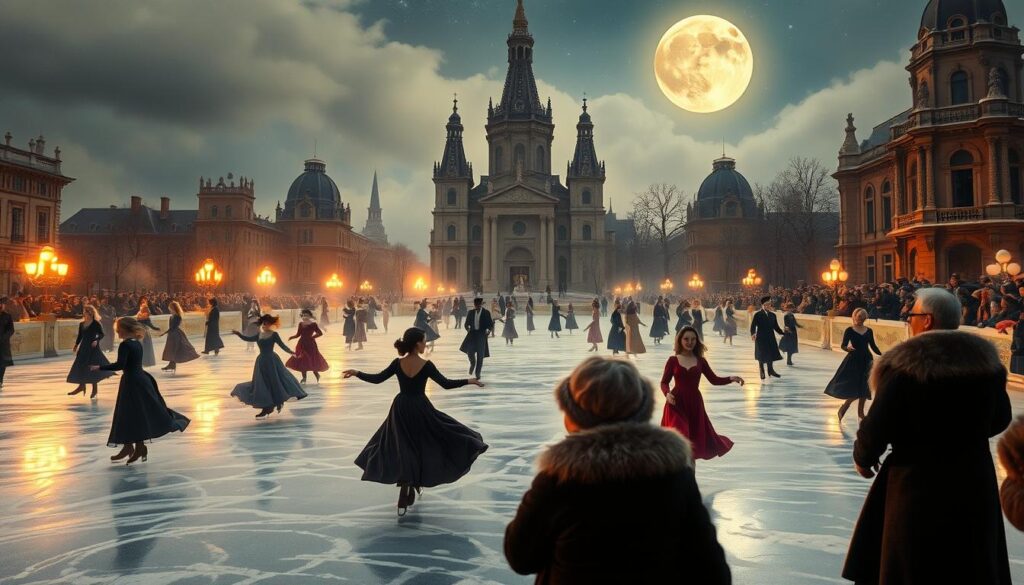
Who made ice skating’s modern style? It was Jackson Haines, a key figure. He changed figure skating by adding dance moves to it.
Jackson Haines: A Skating Visionary
Haines made ice skating into an art form. He brought in new ways to move on ice. These included:
- Fluid, balletic movements on ice
- Incorporation of musical interpretation
- Dynamic spins and jumps
- Elegant, free-flowing skating style
Technical Innovations of the Era
The 19th century also saw big changes in skating gear and skills. Skaters and inventors worked together. They made better equipment to help skaters perform better.
| Innovation | Impact | Year Introduced |
|---|---|---|
| Steel Blade Design | Improved Maneuverability | 1850s |
| Curved Blade Edges | Enhanced Turning Capabilities | 1860s |
| Specialized Skating Boots | Better Ankle Support | 1870s |
These changes helped make figure skating what it is today. Jackson Haines was a big reason ice skating became an art form.
The Rise of Competitive Ice Skating
Competitive ice skating changed the sport’s history in a big way. It moved from small community events to big international competitions. This change showed off athletes’ skills and creativity.
The first competitive skating events started in the late 1800s. This was a big step in ice skating’s history. Athletes began to set new standards of excellence, shaping the sport for years to come.
- First organized competitions emerged in European countries
- Initial events focused on speed and technical precision
- Skating clubs became breeding grounds for competitive talent
Competitive skating led to amazing advancements. Skaters created new techniques and complex moves. These moves amazed people all over the world.
| Competitive Era | Key Developments | Global Impact |
|---|---|---|
| 1890-1920 | First international competitions | Growing international interest |
| 1920-1950 | Introduction of judging systems | Standardized competitive rules |
| 1950-1980 | Olympic recognition | Global sporting phenomenon |
Competitive ice skating keeps inspiring athletes and fans. It has grown from a small hobby to a worldwide sport. It celebrates human talent and artistic skill.
Ice Skating’s Impact on Winter Sports
Ice skating’s history is more than just gliding on ice. It has sparked many winter sports that thrill athletes and fans globally.
Who came up with ice skating techniques that changed winter sports? It was the creative changes in early skating that led to new sports.
Development of Hockey Skates
Hockey skates were a big leap from traditional ice skates. They allowed for:
- Rapid directional changes
- Enhanced maneuverability on ice
- Shorter blade profiles for quick acceleration
- Reinforced boot designs for player protection
Early hockey players tweaked skating tech to fit the sport’s fast-paced nature.
Speed Skating Evolution
Speed skating is another key area where ice skating tech advanced. Athletes turned basic skating into a fast-paced sport.
- Longer, more streamlined blades developed
- Aerodynamic body positioning refined
- Specialized training techniques emerged
Speed skating shows how ice skating’s basics can be taken to new heights, from local ponds to Olympic tracks.
Ice skating’s innovation keeps inspiring athletes. It shows that this ancient activity has evolved into a dynamic, world-loved sport.
Modern Ice Skating Technology
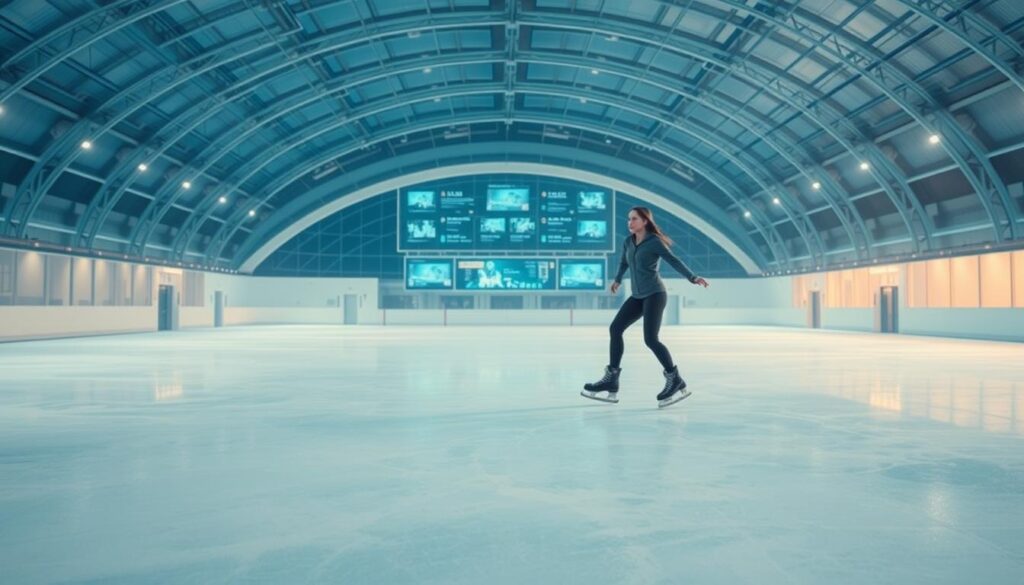
The world of ice skating has changed a lot with new technology. From the first ice skates to today’s top gear, tech keeps improving what’s possible on ice.
Today’s ice skating tech is a huge step up from the old bone skates. Now, designers and engineers use new materials and smart designs. They make gear that boosts performance and comfort.
- Carbon fiber blade constructions
- Computer-aided boot design
- Motion-capture training systems
- Synthetic ice surface technologies
Now, pro skaters get a lot of tech help. Blade materials have evolved to provide unprecedented precision and responsiveness. Makers use computers and science to make blades that save energy and cut down on friction.
Climate-controlled rinks and fake ice have changed how skaters train. These new tools let skaters skate all year, not just in winter.
Tools like high-speed cameras and sensors give skaters detailed feedback. They help athletes improve their moves with great accuracy.
- Real-time performance tracking
- 3D biomechanical analysis
- Advanced material engineering
The future of ice skating tech looks even brighter. As science and materials science get better, skaters will see even more amazing gear. This gear will help them reach new heights on ice.
Ice Skating’s Cultural Influence
Ice skating is more than just a sport; it’s a cultural phenomenon that has inspired many. It has touched the hearts of artists, writers, and creators for generations. The origins of ice skating have sparked countless artistic expressions, creating a rich tapestry of creativity.
The artistic world has seen ice skating in new ways, turning it into a cultural symbol. Its origins may have started in survival, but today it stands for grace, passion, and human achievement.
Impact on Art and Literature
Visual artists have always been drawn to ice skating’s beauty. They paint the balance between human movement and winter landscapes. These paintings and photographs celebrate the sport’s beauty.
- Romantic paintings depicting winter skating scenes
- Photography showing athletes’ dynamic movements
- Sculptures exploring the human form in motion
Popular Culture References
Ice skating has made its mark in movies and literature worldwide. Classic films like The Cutting Edge and I, Tonya have brought skating’s drama to the big screen.
- Iconic movie skating sequences
- Literary works featuring skating protagonists
- Music and dance performances inspired by skating
The cultural impact of ice skating keeps growing. It shows both its historical roots and its modern-day importance in art.
The Science Behind Ice Skating
Ice skating is a blend of science and art. It turns a simple winter activity into a beautiful dance of physics. The history of ice skating shows how knowing about molecules helps us move smoothly on ice.
Ice skating works because of special physical properties. When a skate blade presses on ice, it makes a thin layer of water. This layer reduces friction, making it easy to glide. This idea was key for the inventors of ice skating, showing how science helps us move on ice.
- Molecular pressure creates a thin water film
- Blade design impacts gliding efficiency
- Temperature and ice crystal structure influence skating performance
Skaters use science in their performances:
- Friction reduction: They use precise blade technique to cut down on resistance
- Momentum transfer: They turn stored energy into movement
- Centripetal force: This helps them do turns and spins
Professional athletes use these ideas to do amazing jumps and complex moves. They turn science into art, creating stunning performances.
Conclusion
The story of ice skating is one of human creativity and adaptation. It started as a way to survive in Northern Europe and has grown into a global sport. For thousands of years, people have used ice skates to move through winter landscapes.
Ice skating began as a survival tool and grew into an art and sport. It shows how humans can turn practical ideas into cultural treasures. Skaters from different times have added their own styles, from Vikings to Olympic athletes.
Ice skating is more than a fun activity. It shows our resilience, creativity, and drive to explore and succeed. It’s a story that keeps growing, inviting everyone to try it out.
Whether you’re a pro, a hobbyist, or just starting, ice skating’s history welcomes you. What will you contribute to this long-standing tradition?
